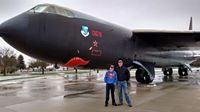
Those of you who drive onto Fairchild Air Force Base have surely noticed the B-52 parked a short ways inside the gate. Well, we know for sure that my father, Col. Francis H. Potter, commanded that very plane for many missions during the Cold War of the 70s. How do we know that? This is a photo of that B-52 and our son, Benjamin, and his son Austin. Ben researched the serial number of that plane and discovered this wonderful bit of family history. And to think that it was OUR father’s plane that was chosen for permanent display!
Fairchild has quite a history. Several battles of U.S. Cavalry vs. Native Americans happened in that very patch of ground. Groups of immigrant settlers established homes, farms and orchards in that same area. The area looked prime for wheat farming. But Spokane was growing in population and that population needed transportation and the opportunity for business.
By 1939, Spokane was in a serious business decline when James A. Ford came to the rescue. Ford had been active with the Spokane Chamber of Commerce since 1917 and during that time he had worked incessantly to bring aviation to Spokane. But the Army Signal Corps reported that “the city is located in a valley between high hills, with contrary winds and there will never be much, if any, aviation in Spokane.”
At this time, Spokane has two airlines flying into Felts Field, United and Northwest. Ford knew Spokane would soon need a bigger airport. And, just as important, he could see the war clouds gathering around the world and hoped a larger airport would attract an Army Air Force Base.
Ford’s work worked and in 1940 a WPA project started to clear and level the county land, donated by the county, for the new field and the Army Air Forces moved right in. The airport was renamed Geiger Field; after WWII it became Spokane International Airport.
About this same time, the announcement was made that the Army Air Force needed a separate and larger base for its operations. Again, James Ford to the rescue. It was a real battle of words, but those on the West side of the state wanted the new depot in their backyard.
The Spokesman Review trumpeted the headline on September 11, 1941, that Spokane would get the $20-million air depot. This was great news for Spokane for it meant an estimated $8-million dollar payroll in the area due to 5400 new jobs. Not to mention the military personnel’s spending in the area.
It turned out that having a military depot so close to a civilian airfield had its advantages, primarily being that a rail line bisected the area.
Citizens of Spokane might have been jubilant but the eleven farmer-land-owners were not. Four sections of prime wheat land would now be gone forever.
The town of Airway Heights got its start during the war years mostly because there was no military family housing at the depot. In 1955, the town of Airway Heights was incorporated.
In 1951, the name was changed from Spokane Air Force Base to Fairchild Air Force Base in honor of Gen. Muir S. Fairchild, a native of Bellingham, Washington.
(Thanks to a 1976 little book by Peggy Bal, Fairchild: Heritage of the Spokane Plains. Please forgive me if I garbled the facts a bit.)